Red Sgraffito Seed Pot with Stylized Avanyu by Art Cody - C3771i
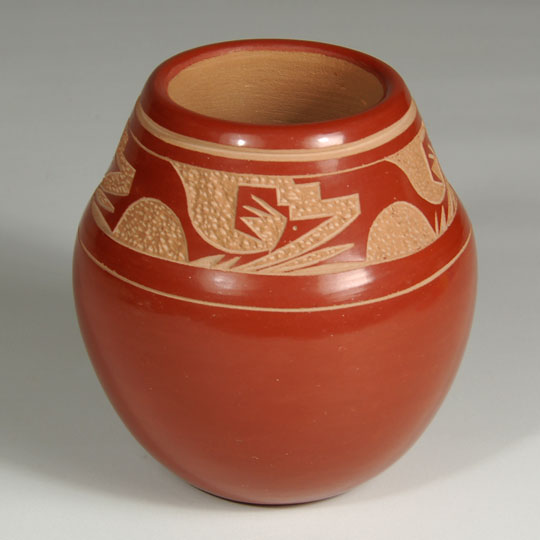 Haungooah means "sunlight reflecting off a buffalo horn" in the Kiowa language. Art Cody was the grandson of famous Kiowa ledger artist Silver Horn, who was known as Haungooah. Following in his grandfather's footsteps, the younger Haungooah became an innovative artist. In the late 1960s, Cody was among the first artists to use the sgraffito technique on pueblo pottery. He married a talented Santa Clara potter, Martha Suazo, who encouraged him to decorate her pieces. Together they won numerous prizes during the 1970s. They signed their work "Haungooah" in honor of Art's grandfather. When Martha passed away sometime after 1979, he continued to create and decorate his own work, until his untimely death only a few years later in 1985.
Haungooah means "sunlight reflecting off a buffalo horn" in the Kiowa language. Art Cody was the grandson of famous Kiowa ledger artist Silver Horn, who was known as Haungooah. Following in his grandfather's footsteps, the younger Haungooah became an innovative artist. In the late 1960s, Cody was among the first artists to use the sgraffito technique on pueblo pottery. He married a talented Santa Clara potter, Martha Suazo, who encouraged him to decorate her pieces. Together they won numerous prizes during the 1970s. They signed their work "Haungooah" in honor of Art's grandfather. When Martha passed away sometime after 1979, he continued to create and decorate his own work, until his untimely death only a few years later in 1985.
Buff-on-red Santa Clara Seed Jar with Upturned Neck by Denny Gutierrez - C3637J
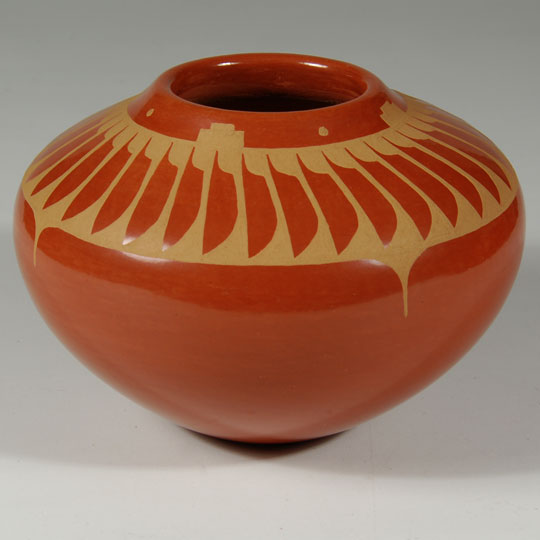 The artist made a slight modification to placement of the feather design from that seen by most potters from Santa Clara and San Ildefonso. He placed the feathers at a slight variant from perfectly straight up and down-that is they are slightly angled. He also added stepped designs and small dots between the feather band and the neck of the jar as well as inverted spikes pendant from the bottom of the feather design. This Southwest Indian pottery jar was beautifully burnished and perfectly fired. It is signed Denny Gutierrez Santa Clara and dated '86.
The artist made a slight modification to placement of the feather design from that seen by most potters from Santa Clara and San Ildefonso. He placed the feathers at a slight variant from perfectly straight up and down-that is they are slightly angled. He also added stepped designs and small dots between the feather band and the neck of the jar as well as inverted spikes pendant from the bottom of the feather design. This Southwest Indian pottery jar was beautifully burnished and perfectly fired. It is signed Denny Gutierrez Santa Clara and dated '86.
Black-on-black Santa Clara Chimney-neck Jar by Denny Gutierrez - C3637i
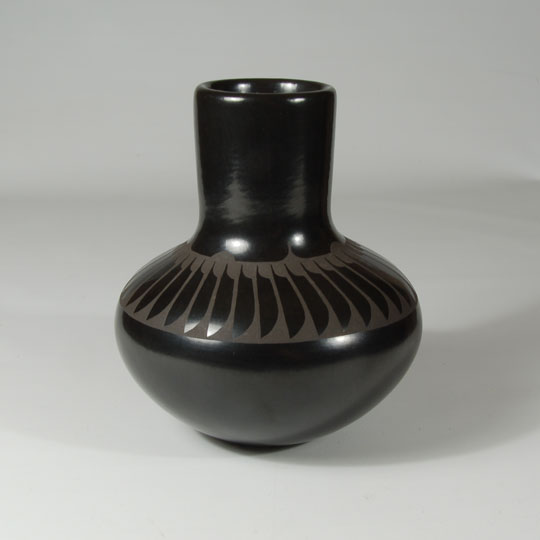 Denny Gutierrez is a potter producing absolutely well balanced and beautifully burnished blackware. This older jar by him, with a tall cylindrical neck, features well-proportioned and spaced feather designs on the shoulder. It is a beautifully graceful jar.
Denny Gutierrez is a potter producing absolutely well balanced and beautifully burnished blackware. This older jar by him, with a tall cylindrical neck, features well-proportioned and spaced feather designs on the shoulder. It is a beautifully graceful jar.
J.D. Roybal Painting of Koosa Clown Admonishing Someone - C3631C
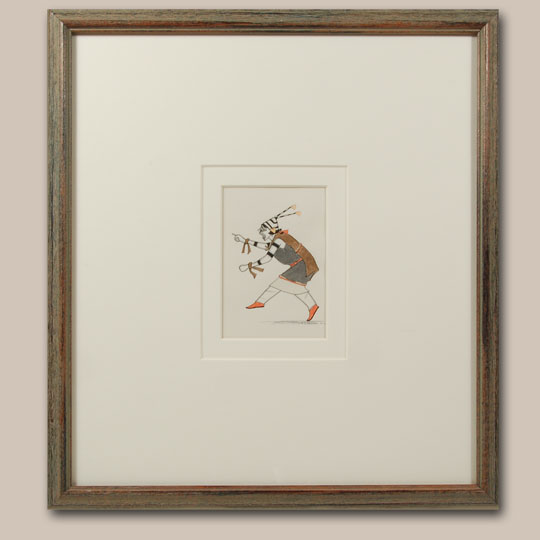 J. D. Roybal, whose full name was José Disiderio Roybal, and who's Tewa name was Oquwa (Rain God), was a well-known painter from San Ildefonso Pueblo. He was born on November 7, 1922 at San Ildefonso, the son of Tonita and Juan Cruz Roybal. He passed away June 28, 1978. He was a nephew of Alfonso Roybal (Awa Tsireh). He did a bit of painting in the 1930s but was not very productive until the 1950s. He was most productive in the 1960-1970 decades.
J. D. Roybal, whose full name was José Disiderio Roybal, and who's Tewa name was Oquwa (Rain God), was a well-known painter from San Ildefonso Pueblo. He was born on November 7, 1922 at San Ildefonso, the son of Tonita and Juan Cruz Roybal. He passed away June 28, 1978. He was a nephew of Alfonso Roybal (Awa Tsireh). He did a bit of painting in the 1930s but was not very productive until the 1950s. He was most productive in the 1960-1970 decades.
J.D. Roybal Painting Koosa Clown with Evergreen Boughs - C3631B
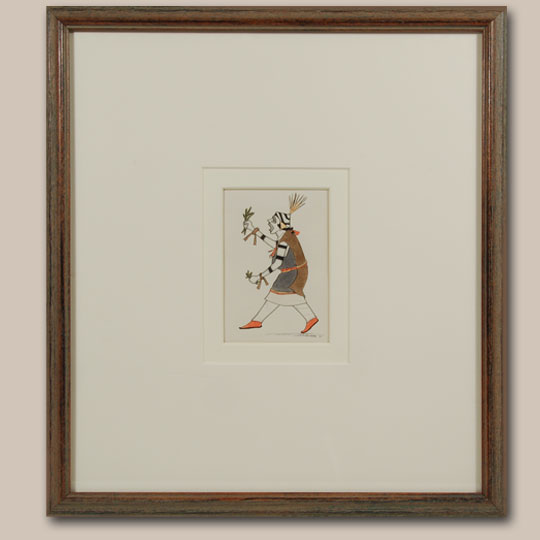 José Disiderio (J.D.) Roybal [1922-1978] Oquwa - Rain God was an accomplished artist. He spent a considerable amount of his time painting small notecard size paintings of a single dancer or two such as this one. This Koosa Clown appears to be performing in a ceremonial function as he has evergreen boughs as seen with dancers during the Corn Dance or Harvest Dance.
José Disiderio (J.D.) Roybal [1922-1978] Oquwa - Rain God was an accomplished artist. He spent a considerable amount of his time painting small notecard size paintings of a single dancer or two such as this one. This Koosa Clown appears to be performing in a ceremonial function as he has evergreen boughs as seen with dancers during the Corn Dance or Harvest Dance.
J.D. Roybal Painting of Koosa Clown Holding Basket - C3631A
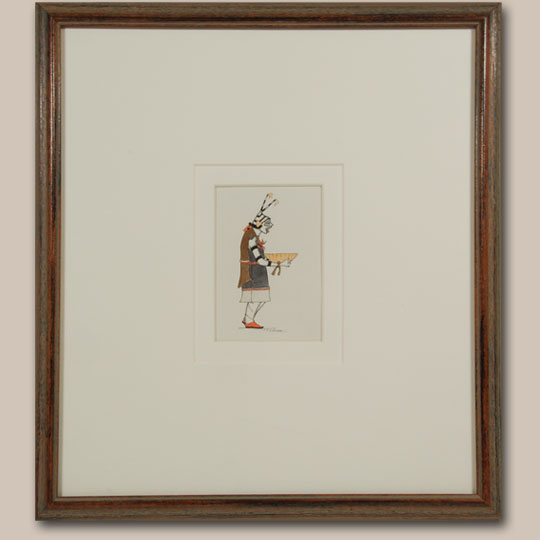 J. D. Roybal, whose full name was José Disiderio Roybal, and who's Tewa name was Oquwa (Rain God), was a well-known painter from San Ildefonso Pueblo. He was born on November 7, 1922 at San Ildefonso, the son of Tonita and Juan Cruz Roybal. He passed away June 28, 1978. He was a nephew of Alfonso Roybal (Awa Tsireh). He did a bit of painting in the 1930s but was not very productive until the 1950s. He was most productive in the 1960-1970 decades.
J. D. Roybal, whose full name was José Disiderio Roybal, and who's Tewa name was Oquwa (Rain God), was a well-known painter from San Ildefonso Pueblo. He was born on November 7, 1922 at San Ildefonso, the son of Tonita and Juan Cruz Roybal. He passed away June 28, 1978. He was a nephew of Alfonso Roybal (Awa Tsireh). He did a bit of painting in the 1930s but was not very productive until the 1950s. He was most productive in the 1960-1970 decades.
Hopi Miniature Chaveyo (Black Ogre) Katsina Doll by Nate Ahownewa - C3627F
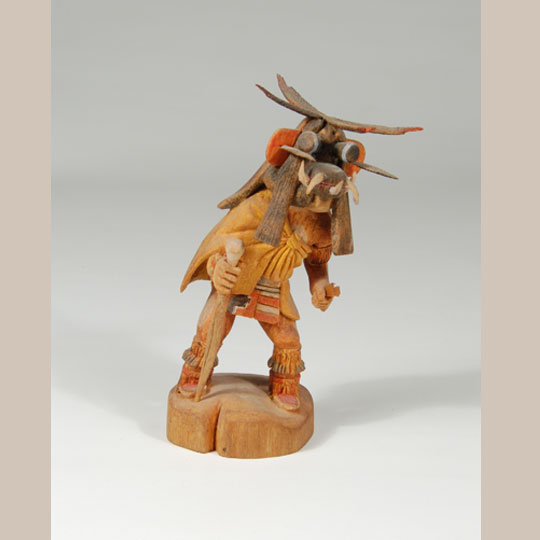 "Chaveyo is one of the more cosmopolitan kachinas. He is represented in nearly every pueblo, but his original home was probably in the San Juan area of New Mexico. However, for the Hopis his home is in the San Francisco Mountains, and he is the husband of Hahai-i-Wuhti. The family of Hahai-i-Wuhti and Chaveyo are the Nataskas, the dreadful Sosoyok't. Chaveyo is the Sergeant Snorkle of the kachinas. Should any Hopi fail to meet his obligations in community work or transgress the unspoken rules of conduct for the village, Chaveyo will show him the error of his ways.
"Chaveyo is one of the more cosmopolitan kachinas. He is represented in nearly every pueblo, but his original home was probably in the San Juan area of New Mexico. However, for the Hopis his home is in the San Francisco Mountains, and he is the husband of Hahai-i-Wuhti. The family of Hahai-i-Wuhti and Chaveyo are the Nataskas, the dreadful Sosoyok't. Chaveyo is the Sergeant Snorkle of the kachinas. Should any Hopi fail to meet his obligations in community work or transgress the unspoken rules of conduct for the village, Chaveyo will show him the error of his ways.
Original Painting “Spirit World Figures” by David Chethlahe Paladin - C3665A
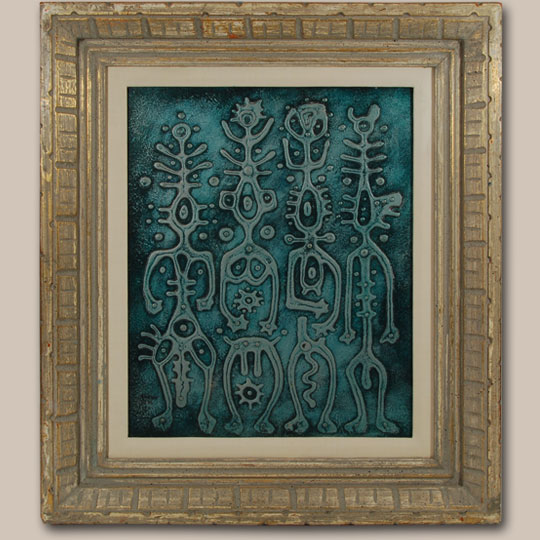 The myths and legends of David Paladin's youth inspire the subject matter of his paintings. On the Navajo Nation, spirit beings inhabit the hills, valleys and mountain peaks. This painting is Paladin's visual interpretation of the spirits that roamed the landscape of his childhood.
The myths and legends of David Paladin's youth inspire the subject matter of his paintings. On the Navajo Nation, spirit beings inhabit the hills, valleys and mountain peaks. This painting is Paladin's visual interpretation of the spirits that roamed the landscape of his childhood.
While in college, he learned to experiment with mixing clay, sand, and mud to develop different textures to fashion his art. This painting has been created using a variety of textures and materials. Four dream-like figures hover in front of a predominately blue background.
Late Nineteenth Century Zuni Pueblo Small Jar circa 1880 - C3645B
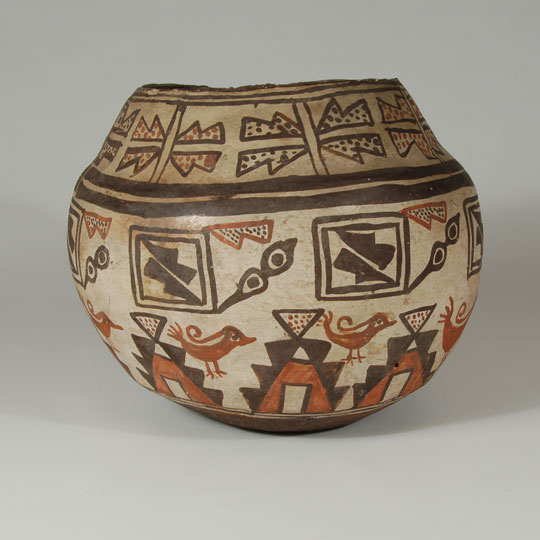 This child-size Zuni polychrome jar is filled with a variety of design elements. The neck design is comprised of L-shaped elements in different positions but all filled with dots-some red and some black. A pair of thin black framing lines at the neck and a pair of wide framing lines at the shoulder define the neck area of decoration.
This child-size Zuni polychrome jar is filled with a variety of design elements. The neck design is comprised of L-shaped elements in different positions but all filled with dots-some red and some black. A pair of thin black framing lines at the neck and a pair of wide framing lines at the shoulder define the neck area of decoration.
The body decoration is a mixture of many elements. The upper row has a series of boxes encircling the vessel body. The boxes are outlined in double black lines and contain arrow-shape elements with an appendage of a pair of circles each containing a black dot, and on the upper corner of the box is an L-shaped element painted red and containing black dots.
Acoma Pueblo Indian Market Ribbon-winner Jar by Wanda Aragon - C3645A
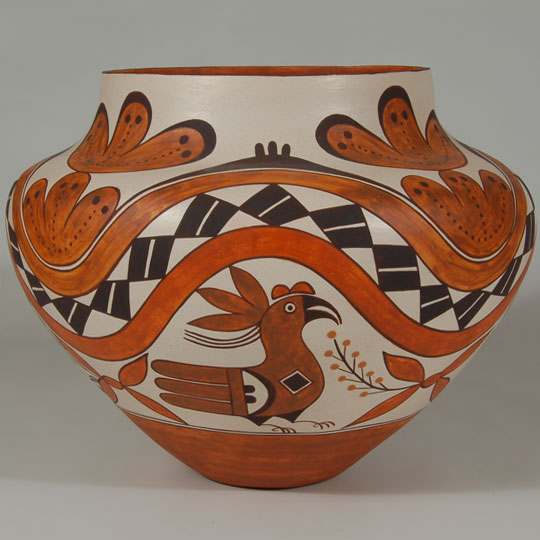 For years, I thought that Wanda Aragon only made miniature pottery as that is all she ever brought to me at the old gallery location in Albuquerque, but this large olla is testimony that she did and probably still does make larger jars. This jar was made in 1999 and was awarded a Third Place award at the Santa Fe Indian Market that year. Wanda has received awards since 1975 and every year from 1987 to 1998 and constantly since then. She is an accomplished potter.
For years, I thought that Wanda Aragon only made miniature pottery as that is all she ever brought to me at the old gallery location in Albuquerque, but this large olla is testimony that she did and probably still does make larger jars. This jar was made in 1999 and was awarded a Third Place award at the Santa Fe Indian Market that year. Wanda has received awards since 1975 and every year from 1987 to 1998 and constantly since then. She is an accomplished potter.
Historic Acoma Pueblo Depressed Rim Jar - C3795
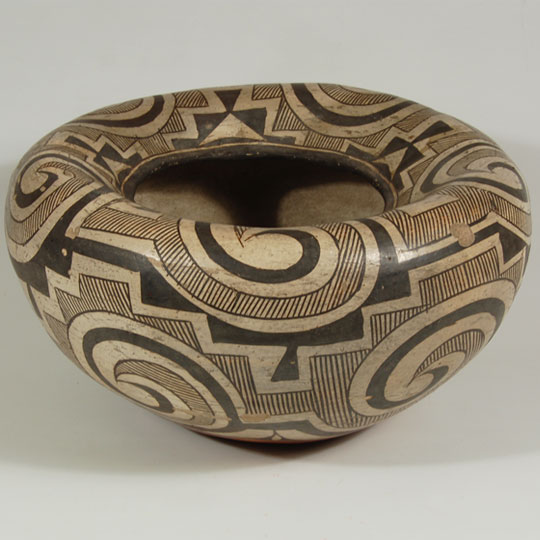 In the early 20th century, potters at Acoma Pueblo began using designs from ancient pottery of theTularosa region of New Mexico. Tularosa Black-on-white pottery existed from 1150 to 1325 A.D. Designs consisted of curvilinear and rectilinear opposed hatched and solid bands. Using these ancestral designs fits well with the concept of adding ground-up potsherds to use as temper in new pottery. Every Acoma pot has a portion of a previous pot incorporated into its existence. Using ancestral designs is a complimentary act.
In the early 20th century, potters at Acoma Pueblo began using designs from ancient pottery of theTularosa region of New Mexico. Tularosa Black-on-white pottery existed from 1150 to 1325 A.D. Designs consisted of curvilinear and rectilinear opposed hatched and solid bands. Using these ancestral designs fits well with the concept of adding ground-up potsherds to use as temper in new pottery. Every Acoma pot has a portion of a previous pot incorporated into its existence. Using ancestral designs is a complimentary act.
Historic Laguna Pueblo Four Color Pottery Pitcher - C3796
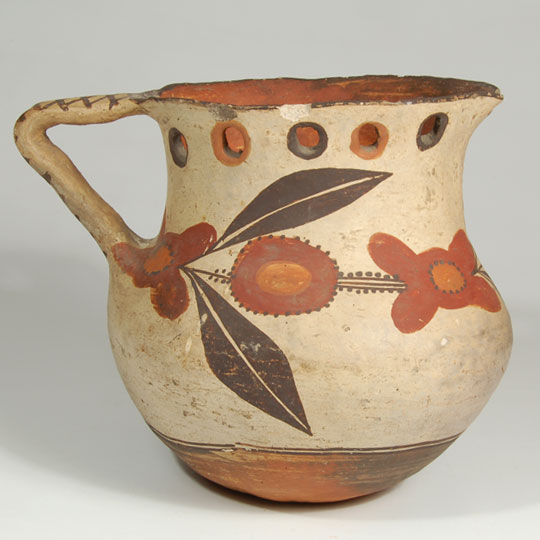 Laguna Pueblo is a nearby neighbor of Acoma Pueblo in Western New Mexico. Laguna was founded in 1699 by members of Acoma, Zuni and other pueblos following the upheavals and disruptions caused by the Pueblo Revolt. Pottery from Laguna resembles that of Acoma and it is generally difficult to distinguish between the two. Some designs, however, seemed to predominate at Laguna and those differed from designs used at Acoma.
Laguna Pueblo is a nearby neighbor of Acoma Pueblo in Western New Mexico. Laguna was founded in 1699 by members of Acoma, Zuni and other pueblos following the upheavals and disruptions caused by the Pueblo Revolt. Pottery from Laguna resembles that of Acoma and it is generally difficult to distinguish between the two. Some designs, however, seemed to predominate at Laguna and those differed from designs used at Acoma.
When the transcontinental train came to New Mexico, it passed directly adjacent to Laguna Pueblo and there was a depot nearby. The train made stops at the pueblo to allow the travelers to purchase wares from the potters. The Laguna potters soon realized that the travelers preferred vessel shapes with which they were familiar. Milk pitchers were very much in use in the Eastern towns and was probably a very saleable item to the tourists. Many other Victorian shapes were equally popular.
Santa Clara Black Polished Jar with Squared Handles by Margaret Tafoya - C3793A
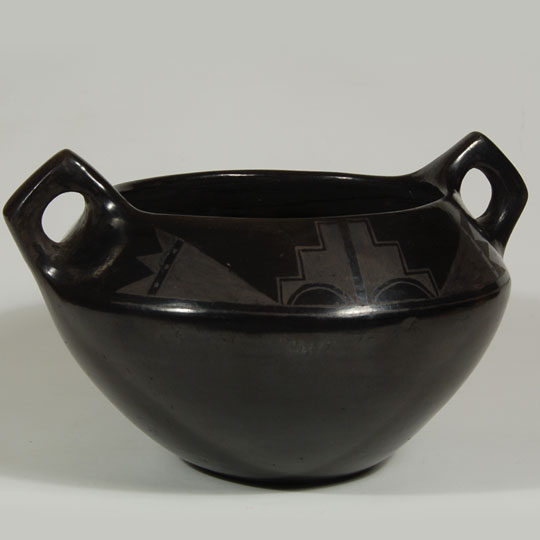 Margaret Tafoya is a name with which all collectors of 20th century pueblo pottery are familiar. She and her family were and are major potters of blackware. Margaret is most normally known for making very large vessels, but she made smaller items as well. Margaret was the last of eight children born to José Geronimo Tafoya (White Flower) and Sara Fina Gutierrez Tafoya (Autumn Leaf). She was given a Tewa name that translates to Corn Blossom and was not given an English name until she was baptized in the Catholic Church as Maria Margarita Tafoya, known now to the world as Margaret Tafoya.
Margaret Tafoya is a name with which all collectors of 20th century pueblo pottery are familiar. She and her family were and are major potters of blackware. Margaret is most normally known for making very large vessels, but she made smaller items as well. Margaret was the last of eight children born to José Geronimo Tafoya (White Flower) and Sara Fina Gutierrez Tafoya (Autumn Leaf). She was given a Tewa name that translates to Corn Blossom and was not given an English name until she was baptized in the Catholic Church as Maria Margarita Tafoya, known now to the world as Margaret Tafoya.
Unusual Red Carved Santa Clara Pueblo Bowl by Sara Fina Tafoya - C3793B
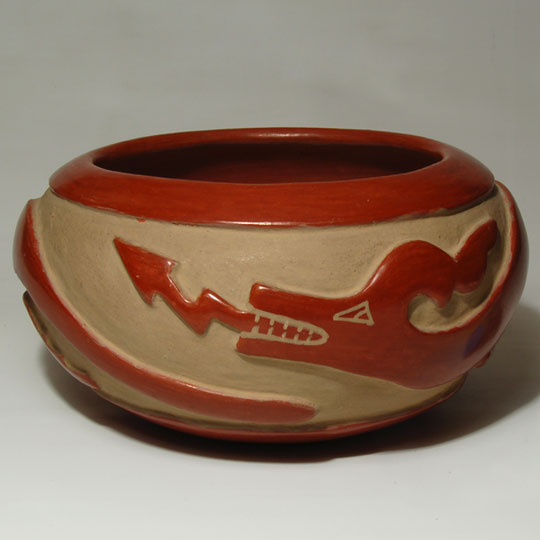 Sara Fina Tafoya is best known for her magnificent black jars, many of which feature bear paws. She is less well known for carved pottery. According to family members, this jar was most likely made by Sara Fina but carved by another family member, probably by her son, Manuel. Serefina Santa Clarais embedded into the clay (see image right). Sara Fina did not sign pottery but other family members are known to have done so for her. She was fluent in Tewa and Spanish, but did not speak or write English.
Sara Fina Tafoya is best known for her magnificent black jars, many of which feature bear paws. She is less well known for carved pottery. According to family members, this jar was most likely made by Sara Fina but carved by another family member, probably by her son, Manuel. Serefina Santa Clarais embedded into the clay (see image right). Sara Fina did not sign pottery but other family members are known to have done so for her. She was fluent in Tewa and Spanish, but did not speak or write English.
Acoma Four-color Polychrome Miniature Olla by Delores Juanico - 25868
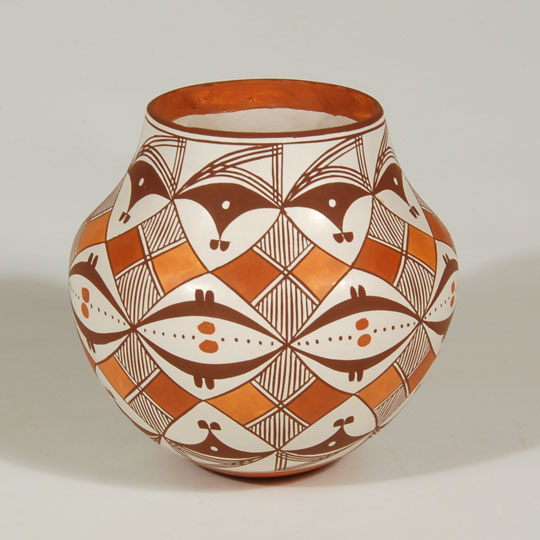 Delores Juanico is a daughter of Marie S. Juanico (1937 - ) who was her mentor. Marie learned pottery principals from her mother, Delores Sanchez, who lived to the age of 103. Young Delores carries on the tradition from her grandmother and mother of making the finest Acoma pottery. Her construction is traditional to Acoma pottery and the vessel walls are amazingly thin and consistent throughout. The design was painted to absolute perfection. Each line is thin and precise, and the application of the fill-in paint is consistent in texture.
Delores Juanico is a daughter of Marie S. Juanico (1937 - ) who was her mentor. Marie learned pottery principals from her mother, Delores Sanchez, who lived to the age of 103. Young Delores carries on the tradition from her grandmother and mother of making the finest Acoma pottery. Her construction is traditional to Acoma pottery and the vessel walls are amazingly thin and consistent throughout. The design was painted to absolute perfection. Each line is thin and precise, and the application of the fill-in paint is consistent in texture.
Hopi Pueblo Ho’ote Katsina Doll - C3776W
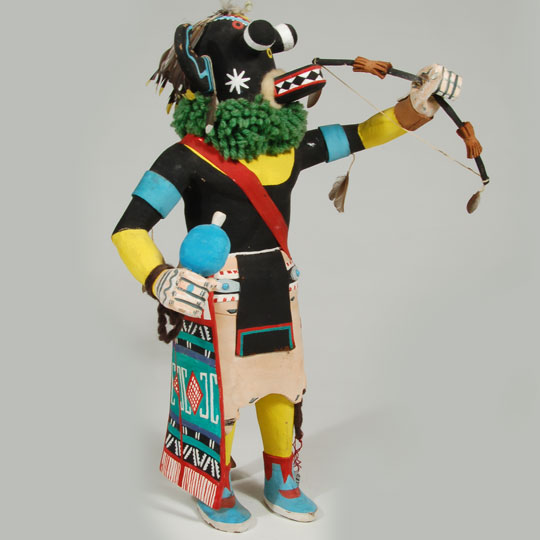 Hopi Katsina dances start in early spring and continue into summer. These dances are religious, their purpose being for rain. The Katsina dances combine music, dance, and ornamentation in one art form providing for the greatest satisfaction of natives and visitors. During these dances, the Katsina dancers show their affection for the Hopi children by presenting them with gifts. Having these dances open to the general public is the Hopi way of sharing their beliefs with non-Hopi and demonstrating that these prayers are not just for the Hopi but for everyone in the world. Following a Katsina dance, Hopi families invite visitors to share in a meal, a display by the Hopi of their hospitality.
Hopi Katsina dances start in early spring and continue into summer. These dances are religious, their purpose being for rain. The Katsina dances combine music, dance, and ornamentation in one art form providing for the greatest satisfaction of natives and visitors. During these dances, the Katsina dancers show their affection for the Hopi children by presenting them with gifts. Having these dances open to the general public is the Hopi way of sharing their beliefs with non-Hopi and demonstrating that these prayers are not just for the Hopi but for everyone in the world. Following a Katsina dance, Hopi families invite visitors to share in a meal, a display by the Hopi of their hospitality.
Original Painting of an Antelope Katsina by Kyrate Tuvahoema - C3788B
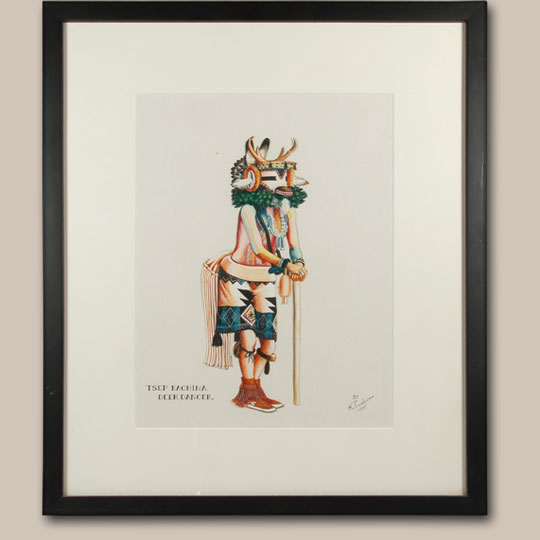 A student of Indian schools at Hopi Pueblo as well as in Santa Fe and Albuquerque, Kyrate Tuvahoema (1914-1942), was known for his depictions of Katsinas that were "tall and lean, but with good detail and color in costume, mask, and paraphernalia.Tanner Modeling, or the use of shading to give depth, was not Tuvahoema's strong suit, but his drafting was thought to be very precise. Tuvahoema spent much of his adult life in sanatoriums in Arizona following completion of school. He died from tuberculosis at the age of 28. Most of his paintings were done in the late 1930s.
A student of Indian schools at Hopi Pueblo as well as in Santa Fe and Albuquerque, Kyrate Tuvahoema (1914-1942), was known for his depictions of Katsinas that were "tall and lean, but with good detail and color in costume, mask, and paraphernalia.Tanner Modeling, or the use of shading to give depth, was not Tuvahoema's strong suit, but his drafting was thought to be very precise. Tuvahoema spent much of his adult life in sanatoriums in Arizona following completion of school. He died from tuberculosis at the age of 28. Most of his paintings were done in the late 1930s.
Black-on-Black Avanyu Design Plate by Maria and Santana Martinez - 22974
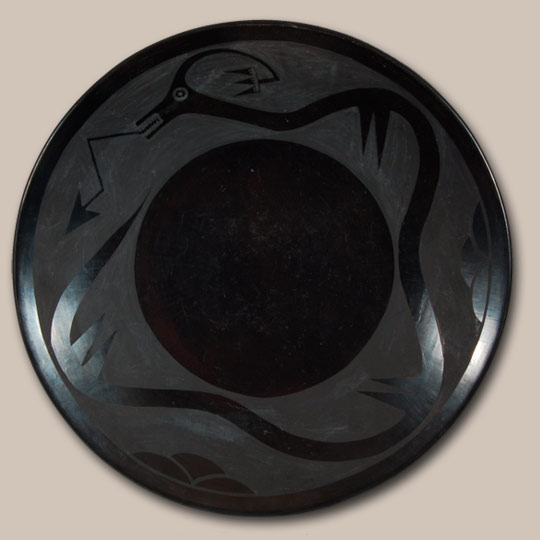 Maria and Julian Martinez certainly established blackware pottery as a collectible for many generations to come. When Julian passed away in 1943, Maria was left with no one to paint the designs on her exquisite masterpieces. It was then that Santana Martinez, wife of Maria's oldest son, Adam, stepped in and began painting the designs for her mother-in-law. Santana continued doing this until 1956, when Maria's other son, Popovi Da, started painting for his mom.
Maria and Julian Martinez certainly established blackware pottery as a collectible for many generations to come. When Julian passed away in 1943, Maria was left with no one to paint the designs on her exquisite masterpieces. It was then that Santana Martinez, wife of Maria's oldest son, Adam, stepped in and began painting the designs for her mother-in-law. Santana continued doing this until 1956, when Maria's other son, Popovi Da, started painting for his mom.
Hopi Polychrome Globular Jar by Dextra Quotskuyva Nampeyo - C3792A
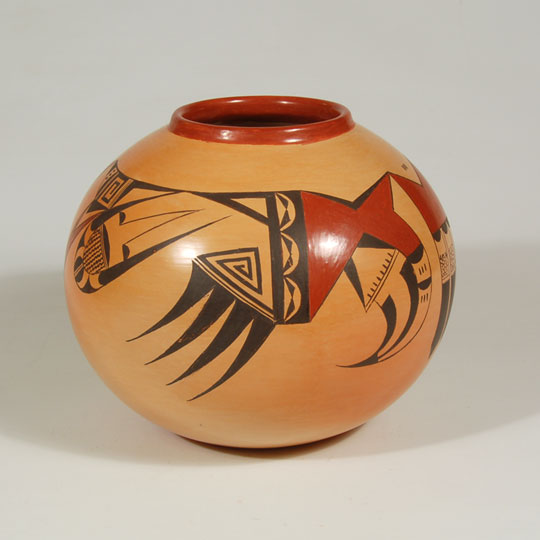 Dextra Quotskuyva Nampeyo (1928- ) grew up in a household of potters who worked everyday, making pottery to sell to tourists, dealers and museums. Her mother was Rachel Namingha and her grandmother was Annie Healing, oldest daughter of Nampeyo of Hano. Nampeyo was still alive when Dextra was born and Dextra got to know her great grandmother for a dozen years before Nampeyo passed away. As a young child, Dextra did what all young girls did-she helped gather and process clay. She later was allowed to fill in designs that were drawn on pottery. This was the learning process for young girls who would be a future generation of potters.
Dextra Quotskuyva Nampeyo (1928- ) grew up in a household of potters who worked everyday, making pottery to sell to tourists, dealers and museums. Her mother was Rachel Namingha and her grandmother was Annie Healing, oldest daughter of Nampeyo of Hano. Nampeyo was still alive when Dextra was born and Dextra got to know her great grandmother for a dozen years before Nampeyo passed away. As a young child, Dextra did what all young girls did-she helped gather and process clay. She later was allowed to fill in designs that were drawn on pottery. This was the learning process for young girls who would be a future generation of potters.
Historic Hopi Pueblo Polychrome Polacca Bowl - 25799
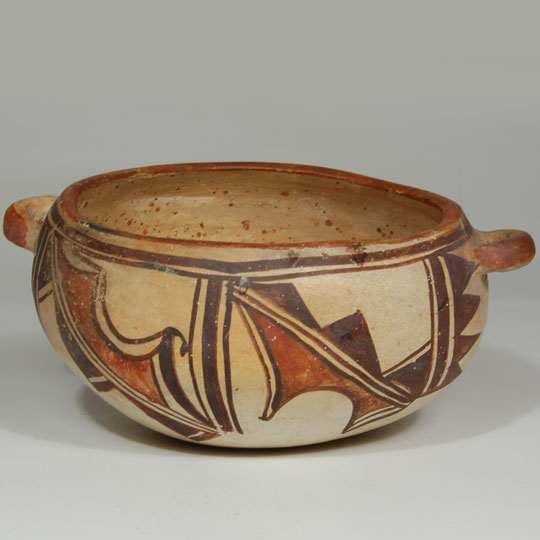 Polacca pottery style began around 1740. It did not become the predominant style at Hopi Pueblo until about 1800, and it continued to be until about 1890. Polacca wares were the predominant utilitarian wares of this time period. This small bowl is covered in Polacca slip which traditionally crazes with age.
Polacca pottery style began around 1740. It did not become the predominant style at Hopi Pueblo until about 1800, and it continued to be until about 1890. Polacca wares were the predominant utilitarian wares of this time period. This small bowl is covered in Polacca slip which traditionally crazes with age.

